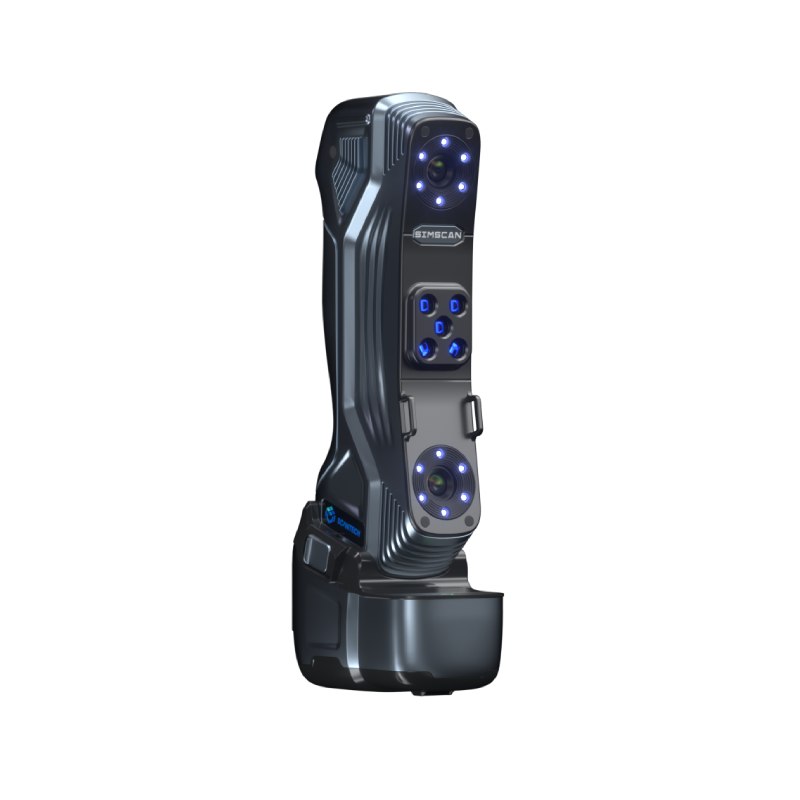Basic of GD&T
In modern manufacturing, 3D scanning technology is rapidly transforming the way parts are designed and quality is controlled.
Imagine a scenario where you need to replace a critical component in a piece of equipment that has been in operation for many years, but unfortunately, the original design drawings are no longer available.
This combination not only allows you to recreate the part’s functionality but also optimizes its design to meet modern manufacturing processes. This article will guide you through the fundamental concepts and definitions of GD&T and explore the advantages of integrating GD&T with 3D scanning in the industry.
What is GD&T?
Geometric Dimensioning and Tolerancing (GD&T) is a globally recognized engineering language used to precisely define the dimensions, shape, orientation, and location of a product’s features through symbols and standardized rules.
It communicates the design intent to design, manufacturing, and quality control teams via technical drawings or 3D models. By allowing for broader tolerance requirements while still meeting functional needs, GD&T helps reduce manufacturing costs.
The goal of GD&T is to minimize errors during the manufacturing process and ensure that parts can be correctly assembled and function properly, even under the most unfavorable conditions.
GD&T originated in the 1940s, created by engineer Stanley Parker, to address the limitations of traditional tolerance systems. It quickly evolved into the core language of modern manufacturing.
GD&T is defined through a set of international standards, such as ASME Y14.5 and ISO 1101, which are regularly updated to align with contemporary engineering practices.
While ASME standards are primarily used in the United States, ISO standards are widely applied in other countries and regions.
The use of GD&T not only optimizes product design and production but also reduces misunderstandings between research, process, manufacturing, and quality control departments, ensuring effective collaboration across teams and borders.
How Does GD&T Work?
Imagine a scenario where a technical drawing is sent to the manufacturing floor, but there is a misunderstanding between the designer and the workers regarding the part’s geometric features and tolerances. This could lead to significant waste or even rework.
Geometric Dimensioning and Tolerancing (GD&T) was specifically designed to resolve such communication barriers.
GD&T is a symbolic language that enables everyone in the team—from designers to manufacturers—to communicate clearly and consistently about the part’s features and tolerances using a standardized language.
GD&T uses geometric characteristics and tolerance categories to define each controlled feature of a part. It also introduces reference datums (such as points, lines, and planes) as points of reference, associating other features with these datums.
This approach not only reduces misunderstandings but also eliminates guesswork, making the manufacturing process smoother. For example, while a part’s height tolerance might meet specifications, if its surface is not flat enough, it cannot be practically used.
GD&T ensures that design intent is accurately conveyed to the manufacturing stage by controlling surface flatness tolerance.
Additionally, GD&T utilizes concepts like Maximum Material Condition (MMC) and Least Material Condition (LMC) to help engineers assess whether a part will still assemble and function properly under extreme tolerance conditions.
For instance, when designing chain links, GD&T accounts for the effects of tolerance stacking, preventing overall length deviation caused by cumulative errors.
By using relevant location methods instead of traditional fixed edge positioning, GD&T significantly improves the precision of assembly.
Types of GD&T Symbols
Geometric Dimensioning and Tolerancing (GD&T) is a system of symbols used to precisely describe part features on engineering drawings. These symbols are categorized based on their function and are divided into the following types:
1. Form Tolerances
These control the shape accuracy of features.
| Symbol | Tolerance Type | Description | Standard |
 |
Straightness | Ensures the straightness of an element | ASME Y14.5 / ISO 1101 |
 |
Flatness | Ensures the flatness of a surface | ASME Y14.5 / ISO 1101 |
 |
Circularity | Ensures the roundness of a cross-section | ASME Y14.5 / ISO 1101 |
 |
Cylindricity | Ensures the cylindrical shape of a feature | ASME Y14.5 / ISO 1101 |
2. Orientation Tolerances
These control the orientation of features relative to a datum.
| Symbol | Tolerance Type | Description | Standard |
 |
Parallelism | Ensures a feature is parallel to a datum | ASME Y14.5 / ISO 1101 |
 |
Perpendicularity | Ensures a feature is perpendicular to a datum | ASME Y14.5 / ISO 1101 |
 |
Angularity | Ensures a feature is at a specified angle to a datum | ASME Y14.5 / ISO 1101 |
3. Location Tolerances
These control the position accuracy of features.
| Symbol | Tolerance Type | Description | Standard |
 |
Position | Ensures a feature is in its specified location | ASME Y14.5 / ISO 1101 |
 |
Concentricity | Ensures a feature’s axis aligns with a datum axis | ASME Y14.5 / ISO 1101 |
 |
Symmetry | Ensures a feature is symmetric relative to a datum | ASME Y14.5 / ISO 1101 |
4. Profile Tolerances
These control the shape accuracy of complex curves or surfaces.
| Symbol | Tolerance Type | Description | Standard |
 |
Profile of a Line | Controls the shape of a 2D cross-section | ASME Y14.5 / ISO 1101 |
 |
Profile of a Surface | Controls the shape of a 3D surface | ASME Y14.5 / ISO 1101 |
5. Runout Tolerances
These control the error of rotating features.
| Symbol | Tolerance Type | Description | Standard |
 |
Profile of a Line | Controls the shape of a 2D cross-section | ASME Y14.5 / ISO 1101 |
 |
Profile of a Surface | Controls the shape of a 3D surface | ASME Y14.5 / ISO 1101 |
6. Datum Symbols
Used to denote datum points, lines, or planes
| Symbol | Tolerance Type | Description | Standard |
 |
Datum Reference | Marks datum positions | ASME Y14.5 / ISO 1101 |
7. Feature Control Frame

The Feature Control Frame (FCF) specifies geometric tolerances on drawings. The leftmost box indicates the controlled characteristic (e.g., position).
The second box shows the tolerance zone shape (e.g., diameter) and numerical tolerance. Adjacent boxes list datum references (e.g., B and C in the example).
Optional feature modifiers include:
● M: Maximum Material Condition (MMC)
● L: Least Material Condition (LMC)
● U: Unequal Bilateral Tolerance (e.g., -0.20mm/+0.80mm)
● P: Projected Tolerance Zone
Why is GD&T So Important?
Improved Assembly Quality
While traditional tolerance methods can design precise individual parts, they do not ensure proper interaction between parts during assembly. GD&T provides a more efficient approach to ensure accurate fitting of parts within larger assemblies.
For example, a connecting rod only functions to convert linear motion into rotational motion when properly integrated with the piston and crankshaft. Poor assembly can impact the entire component’s performance. GD&T ensures part integration and fit, enhancing assembly quality.
Simplified Communication
GD&T’s geometric tolerance symbols are universally understood, with clear and simple rules, definitions, and terminology. This standardization enables engineers and designers to more effectively convey design intent, reducing communication errors.
Time and Cost Savings
When a design does not meet its intended function, it may require multiple revisions, wasting both resources and time. GD&T optimizes manufacturing complexity by setting appropriate tolerances and reducing scrap rates, which increases the design’s cost-effectiveness and efficiency.
The symbols provide an intuitive way for other engineers to understand quality assurance, allowing teams to quickly grasp dimension and tolerance specifications, thereby improving collaboration.
Maximized Yield and Cost Efficiency
GD&T allows for broader tolerance ranges, helping to save costs by reducing manufacturing and inspection complexity. For many projects, it also provides additional tolerance allowances, further enhancing economic benefits.
In-Depth Discussion of GD&T and 3D Scanning
The combination of Geometric Dimensioning and Tolerancing (GD&T) with 3D scanning technology has not only enhanced measurement efficiency and accuracy but also transformed traditional approaches to design and quality control in manufacturing.
This integration offers advantages across complex parts design, production, and inspection stages.
1. An Inevitable Combination in Precision Manufacturing
As product complexity increases, traditional measurement methods often fail to meet high precision requirements. For example, in industries like aerospace and medical devices, parts may require tolerances as fine as micrometers.
GD&T provides a unified definition for dimensions and tolerances, while 3D scanning can quickly capture the complete geometric data of parts, ensuring that measurement results reflect real-world manufacturing scenarios.
Practical Applications:
● Aerospace Engine Turbine Blades: Turbine bladeshave complex shapes that traditional measuring instruments struggle to cover entirely. By combining GD&T with 3D scanning, it is possible to quickly validate surface shapes, profile, and symmetry.

● Automotive Industry: Parts such as gearbox housings and engine blocks have strict fit requirements. With 3D scanning, it becomes easier to verify whether parts meet the GD&T specifications.

2. More Efficient Tolerance Evaluation
Traditional manual measurement methods rely on fixed fixtures and inspection equipment, with complex tolerances (such as position and form tolerances) taking considerable time to assess.
Highly complex parts may require multiple devices to be measured together, adding to process complexity and cost.
GD&T and 3D Scanning Solution:
● Full Automation:By using 3D scanners like KSCAN-Magic to capture point cloud data, combined with specialized software (such as PolyWorks, Geomagic Control X, etc.), GD&T features can be automatically recognized, generating complete inspection reports.
● Fast Analysis:Tolerance evaluation results are displayed visually on 3D models, highlighting deviation areas and actual values, helping engineers quickly identify issues.
3. Support for Reverse Engineering and Digital Manufacturing
● Capturing Existing Part Data: When CAD models or design drawings are unavailable, 3D scanning can quickly generate geometric data for a part. By combining this with GD&T, key design parameters and tolerance requirements can be derived.
● Design Optimization:The GD&T standard can be applied to optimize redesign processes, ensuring that new designs align better with manufacturing requirements.
Extension to Digital Manufacturing
● Digital Twin:Using 3D scanning and GD&T standards, a digital twin of the part can be created to support real-time monitoring and feedback during the manufacturing process.
●Smart Factories: By integrating scan data with smart manufacturing systems, online inspection can be achieved, reducing human error and improving accuracy.
4. Cost Reduction and Increased Efficiency
The use of GD&T and 3D scanning technology can significantly reduce the time required for measurement and inspection, decreasing reliance on specialized inspection equipment.
The automation of the inspection process reduces human errors, effectively lowering scrap rates and rework. During the new product trial phase, 3D scanning can quickly generate inspection reports, helping to identify design issues and adjust tolerances promptly.
In mass production, integrating scanning equipment with GD&T analysis software enables real-time monitoring of each part, ensuring consistency and quality in production.
5. Data-Driven Quality Management
Scanning data and GD&T inspection results can be stored as digital files, facilitating future analysis and traceability. By integrating big data analysis tools, companies can identify long-term quality issues in the manufacturing process and further optimize workflows.
Additionally, inspection data can reveal systematic errors in production processes, such as mold wear or process deviations, providing valuable insights for improving production lines.
Summary
The integration of GD&T and 3D scanning technology offers a powerful toolset for improving part quality, optimizing manufacturing processes, and reducing costs and waste.
This combination not only enhances the efficiency of traditional manufacturing but also lays the foundation for smart manufacturing and digital transformation.
In the future, it will become an indispensable core technology in high-end manufacturing and precision engineering fields.
























 All Products
All Products 











 en
en 













